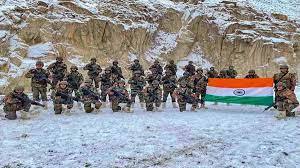Aakanksha Jetley, Pune
In a proactive response to the Galwan Valley confrontation, the Indian Air Force (IAF) conducted an extensive airlift operation on Sunday. The operation swiftly deployed over 68,000 troops and a wide array of essential military equipment to reinforce security measures in Ladakh. This strategic move was aimed at fortifying India’s defence posture along the Line of Actual Control (LAC) following the June 2020 clash.
Amid the continued standoff between Indian and Chinese forces in Ladakh, the IAF’s prompt action showcased its operational agility and the nation’s determination to safeguard its borders. As diplomatic tensions flared and bilateral ties hit a low point after the Galwan Valley incident, the airlift operation sent a powerful message about India’s commitment to maintaining peace and security in the region.
The airlift operation transported a diverse range of assets, including 330 infantry combat vehicles, 90 tanks, artillery guns, surface-to-air guided weapons, and advanced radar systems, to forward positions in eastern Ladakh. This strategic move bolstered India’s ability to respond effectively to potential challenges along the border.
“This massive airlift effort, involving around 9,000 tonnes of cargo transported over the last three years, was essential to strengthening our deterrent military posture and ensuring a robust presence,” said an official familiar with the operation.
Under the stewardship of the Western Air Command, the IAF’s largest operational unit; the airlift operation demonstrated the seamless coordination between various elements of the armed forces. Helicopters played a crucial role in deploying radar systems to monitor the Line of Actual Control (LAC), while fighter aircraft such as Rafales, Sukhoi-30s, and MiG-29s stood ready for combat air patrols and rapid response.
The IAF’s emphasis on maintaining operational readiness in all conditions resonated by deploying front-line fighter jets, attack helicopters, and multi-mission choppers from forward airbases. This move ensured the defence capabilities remained agile, even in challenging terrain and weather conditions.
In line with modern warfare strategies, remotely piloted aircraft systems have proven vital for electronic surveillance and intelligence gathering over the past three years. These technologies were pivotal in tracking enemy movements and strengthening India’s situational awareness.
As the Indian and Chinese militaries engage in ongoing talks to ease tensions and resolve border issues, the IAF’s swift and strategic airlift operation underscores India’s preparedness to secure its territorial integrity. Amid upcoming international engagements, including the BRICS Summit, India’s focus remains steadfast on restoring peace and stability along the border. The IAF’s proactive response is a testament to its dedication to safeguarding the nation’s interests and maintaining regional stability.
